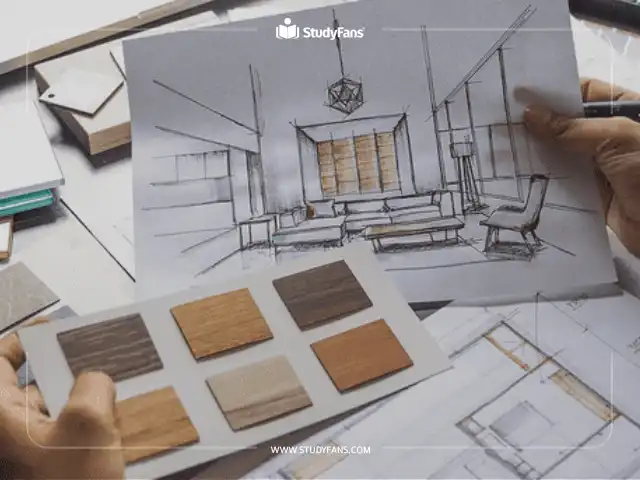Architecture and interior architecture are closely related disciplines that involve the design, planning, and construction of buildings and interior spaces.
Despite similarities between both fields, there are some Differences between interior architecture and architecture which we will discuss in detail through this article. Keep reading.
Overview of the interior architecture degree
An interior architecture degree is a specialized program that focuses on the design and planning of interior spaces. It combines elements of architecture, interior design, and spatial planning to create functional, aesthetically pleasing, and innovative interior environments.
Interior architecture is concerned with the interior spaces within buildings. Interior architects focus on the layout, flow, and functionality of interior spaces, as well as the selection of materials, finishes, and furnishings. They work to create spaces that are not only visually appealing but also functional and comfortable for the occupants.
The curriculum of an interior architecture degree typically covers a range of topics related to :
Design
Construction
Materials
Building systems
Lighting
Color theory
Furniture design
Sustainability
Project management.
Overview of the architectural engineering major
Architectural engineering is a multidisciplinary field that combines principles of engineering with knowledge of architecture to design and construct buildings and other structures.
Architecture focuses on the overall design and functionality of buildings, including the structural elements, facade, layout, and overall aesthetic. Architects work on a broad scale, considering the building's relationship to its surroundings, environmental impact, and user needs.
Some architectural engineering programs offer specializations or concentrations in areas such as :
Structural engineering
Mechanical systems design
Electrical systems design
Building energy performance
Sustainable design.
Advantages of studying the interior architecture major
Advantages of architecture and interior architecture is an important item in the Differences between interior architecture and architecture.
Studying interior architecture can offer a range of advantages and benefits for students interested in this field such as:
1. Creativity and Design Skills
2. Versatile Career Opportunities, including working as
Interior designers
Architectural designers
Space planners
Furniture designers
Set designers, and more
3. Hands-On Experience by studio courses, design projects, internships, and collaborations with industry professionals.
4. Interior architecture focuses on the design and organization of interior spaces, considering factors such as functionality, circulation, lighting, acoustics, materials, and user experience.
5. Collaboration and Communication Skills with architects, engineers, contractors, clients, and other stakeholders.
6. Sustainable Design Practices by creating environmentally friendly and energy-efficient interior spaces that promote sustainability, reduce environmental impact, and contribute to healthier living environments.
7. Global Perspective on design trends, cultural influences, historical contexts, and contemporary practices in the field which enrich students' creativity, broaden their horizons, and inspire new ideas for their design projects.
Advantages of studying architecture major
Studying architecture as a major can offer numerous advantages and benefits for students interested in this field, including:
Architecture is a highly creative and expressive field that allows students to design and create innovative, visually stunning, and functional spaces.
Architecture programs emphasize critical thinking, problem-solving, and analytical skills.
Technical Proficiency as students acquire technical skills in drafting, modeling, rendering, and computer-aided design (CAD) software, which are essential for creating detailed architectural drawings and presentations.
Collaboration and Teamwork with other professionals, such as engineers, contractors, clients, and stakeholders.
The demand for skilled architects is expected to grow as cities expand, infrastructure projects increase, and sustainable design becomes more prevalent.

Courses for the interior architecture major
If you ask about Differences between interior architecture and architecture, you should know the courses available in both fields.
The courses for an interior architecture major typically cover a wide range of topics related to design, spatial planning, building construction, materials, and aesthetics, including:
Technical drawing - drawing by computer
Artificial intelligence
Computer-Aided Drawing (CAD)
Color and Textures
Conceptual Curricula in Interior Design
Environmental Psychology
Materials and Production Techniques for Furniture Design
Interion Creative Production Techniques and Materials
Computer Modeling
Occupational Health and Safety
Interior Architecture Project Management
Professional and portfolio Practices
Courses for architecture major
Architectural history
Architectural design
Architectural engineering
Environmental design
Environmental science
Architecture
Working Drawing
Arts
Interior architecture
Landscape architecture
Design process and communication
Fields of work for graduates of the interior architecture major
Fields of work for graduates of the interior architecture major include:
Interior Designers
Home decoration companies.
Brands of interior decoration.
Commercial and Industrial Designers
3D Visualizer - Renderer
Restaurant Designer
Designer for Hospitality
Retail Designer
Postsecondary Architecture Teachers
Architectural and Civil Drafters
Architects
Building information modeling (BIM) coordinator
Project manager
Sustainability coordinator
Design assistant
Building code specialist
Construction project coordinator
Urban planner
Fields of work for graduates of the architecture major
Graduates of an interior architecture major have a variety of career opportunities in the field of interior design, architecture, and related industries.
Some common fields of work for graduates with a degree in interior architecture include:
Graphic designer
Framer
Project coordinator
Interior designer
Lighting consultant
Computer aided design (CAD) designer
Architectural drafter
Professor
Restoration manager
Architectural technologist
Archivist
Industrial designer
Landscape architect
Urban planner
Building architecture
Structural designer
Architectural historian
Project manager
Computer aided design (CAD) detailer
Researcher
Skills that an interior architecture engineer must have
Students who are interested in Differences between interior architecture and architecture, usually ask about skills that an interior architecture engineer must have.
Interior architecture engineers require a unique set of skills to succeed in their field, including:
Creativity
Spatial awareness
Knowledge of Building Codes and Regulations
Great communication skills
Attention to detail
Creative problem-solving skills
Organizational skills
Time management
Adaptability to new technology
Ability to use sustainable design tools, like LEED,Revit, SketchUp, and AutoCAD
Strong leadership skills
Ability to make smart, quick decisions
Ability to manage project budgets and finances

Skills that an architect must have
Architects play a crucial role in designing and overseeing the construction of buildings and structures. To excel in this profession, architects need to possess a diverse set of skills, including:
Creative thinking
Visual design
Drafting
Drawing
Project management
Analysis skills
Mathematical and engineering skills
Computer programming
Software modeling
Ability to collaborate
Attention to detail
Problem-solving skills
Organizational capability
Communication skills
Client management
Leadership
Feedback
Adaptability
Entrepreneurship
Salaries of interior architecture graduates
Now, we come to the most important item in the Differences between interior architecture and architecture which is the salaries.
Interior architecture can be a rewarding and potentially high-paying career, especially for professionals with the right skills, experience, and expertise.
Salary of interior architecture engineer range between 44.140₺-148,300₺ every month.
Salaries of architecture engineer graduates
The salary of architecture engineering graduates can vary depending on factors such as
Location
Level of experience
Type of employer
Specialization within the field.
Here are some general salary ranges for architecture engineering graduates:
Entry-Level Positions | $40,000 to $60,000 per year. |
Mid-Level Positions | $60,000 to $90,000 per year. |
Experienced architecture engineering graduates with advanced skills and leadership responsibilities | More than $90,000 annually. |
Senior positions | $90,000 to $150,000 or more. |
How to become an interior architect?
After knowing the Differences between interior architecture and architecture and deciding which degree you want, you should ask how to become an interior architect or architect.
Becoming an interior architect involves a combination of education, experience, and licensure. Here are the steps you can take to pursue a career as an interior architect:
Earn a Bachelor's Degree
Gain Work Experience
Consider a Master's Degree
Obtain Licensure by passing the National Council for Interior Design Qualification (NCIDQ) exam or a similar licensing examination specific to your location.
Build a Portfolio showcasing your design projects, concepts, and technical abilities.
Stay Updated on Industry Trends
Develop Soft Skills such as communication, collaboration, problem-solving, and time management. These skills are essential for working effectively with clients, contractors, and other team members.
Seek Professional Certification such as the American Society of Interior Designers (ASID) or the International Interior Design Association (IIDA) to demonstrate your expertise and commitment to the profession.
How to become an architect?
Becoming an architect typically involves completing a combination of education, practical experience, and licensure. Here are the general steps to become an architect:
1. Education
Earning a professional degree in architecture but the program should be accredited by the National Architectural Accrediting Board (NAAB).
Common degree options include :
a Bachelor of Architecture (B.Arch)
a Master of Architecture (M.Arch).
2. Internship
After completing a degree in architecture, aspiring architects typically need to gain practical experience through an internship or architectural apprenticeship program.
3. Examination
In most jurisdictions, architects must pass the Architect Registration Examination (ARE) to become licensed.
The ARE is a series of exams that assess candidates' knowledge and skills in various areas of architecture, including site planning, building design, construction documents, and project management.
4. Licensure
Once you have completed the required education, practical experience, and passed the ARE, you can apply for licensure from the state licensing board where you plan to practice.
5. Continuing Education to maintain your professional credentials.
6. Specialization
Architects can choose to specialize in specific areas of the field, such as sustainable design, historic preservation, healthcare facilities, or urban planning. Specialization may require additional education, training, or certification.
7. Professional Development
Throughout their careers, architects can pursue professional development opportunities such as joining industry organizations, attending conferences and workshops, and networking with other professionals in the field.
What is the Role of an Architect?
The role of an architect is multifaceted and involves a combination of design, technical expertise, project management, and communication skills,in addition to:
Designing buildings and spaces that fulfill the requirements and vision of their clients.
Architects need to have a strong understanding of building codes, regulations, construction techniques, and structural systems. They work closely with engineers and other professionals to ensure that their designs are structurally sound, energy-efficient, and compliant with building standards.
Project Management
Architects must be able to present their designs clearly through drawings, models, and presentations.
In today's environmentally conscious world, architects are increasingly focused on incorporating sustainable design principles into their projects. This includes using eco-friendly materials, optimizing energy efficiency, and designing buildings that minimize their environmental impact.
Problem-Solving
Client Relationships to understand their needs, preferences, and constraints.
What is the Role of an Interior Architect?
An interior architect is a professional who specializes in the design and planning of interior spaces within buildings. They work closely with clients, architects, engineers, and other stakeholders to create functional, aesthetically pleasing, and well-designed interiors.
The role of the interior architect includes the following :
1. Space Planning by analyzing the layout, flow, and functionality of interior spaces to create efficient and effective design solutions that meet the needs of the occupants.
2. Interior architects focus on the aesthetic and decorative aspects of interior spaces, including
Color schemes
Materials
Finishes
Furniture
Lighting
Accessories.
3. Building Codes and Regulations to ensure that their designs comply with relevant laws and guidelines to protect the health, safety, and welfare of occupants.
4. Client Communication to understand their needs, preferences, and budget constraints.
5. Material Selection, finishes, and furnishings that enhance the functionality and aesthetics of interior spaces.
6. Like architects, interior architects are increasingly focused on incorporating sustainable design principles into their projects. They may recommend energy-efficient lighting, eco-friendly materials, and other environmentally conscious design strategies to create healthier and more sustainable interior spaces.
Conclusion
While the Differences between interior architecture and architecture, they often collaborate closely on projects to ensure that the exterior and interior design of a building are cohesive and harmonious. Together, they work to create spaces that are both aesthetically pleasing and functional for their intended use.
If you wanted to know more or have any questions, we are here to help you and you can always contact us:
Phone: 00905437394024
Or via WhatsApp through this link.





